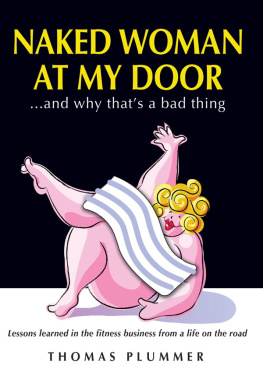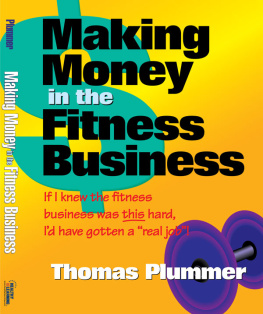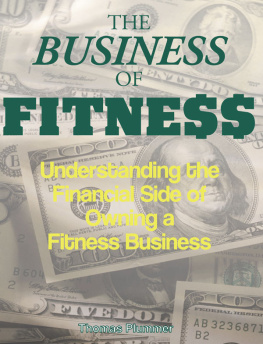Where Did That
Member Go?
Rediscovering the Lost Art
of Member Service
Thomas Plummer

2010 Healthy Learning. All rights reserved. Printed in the United States.
No part of this book may be reproduced, stored in a retrieval system, or transmitted, in any form or by any means, electronic, mechanical, photocopying, recording, or otherwise, without the prior permission of Healthy Learning. Throughout this book, the masculine shall be deemed to include the feminine and vice versa.
ISBN: 978-1-60679-101-1
Library of Congress Control Number: 2010922934
Cover design: Brenden Murphy
Book layout: Deb Oldenburg
Front cover photo: Stockbyte
Healthy Learning
P.O. Box 1828
Monterey, CA 93942
www.healthylearning.com
This book is dedicated to Susan and her children, Jill and CJ, and our granddaughter, Madison. I was late to this family dance. I never expected or dreamed that I would ever have a family of my own, but you have changed my life, and I am grateful for all of you and all the love that you bring. Things like this remind you that if you ever want to make God laugh until the thunder rolls, just show him your plans for your life, and then He will show you where you are really going to go.
I have promised myself, and have proclaimed loudly to many friends, that each coming year will always be my last in this industry. Now, its 30 years later, and the journey still continues. It seems that maybe God is not done with me just yet, and there is more work yet to do.
Last year, a participant in a workshop came up after we had finished to thank me for the two days of fun and education. I thanked him for coming and thanked him for taking the time away from his business. I hadnt realized it at first, but he had been in a workshop a number of years earlier, and I simply didnt recognize him. There was a day that I could remember almost everyone who passed through a seminar, but after well over 50,000 participants it all sort of runs together these days. I apologized for not remembering and thanked him again for the faith and support through the years.
He was with his wife, and they smiled, shook my hand, and turned to go. They got about 10 feet away, and the wife turned and came back. She was crying and gave me a hug, as I stood there bewildered. She told me that they were down to their last few dollars when they first came to the seminar and were very close to losing their club, and perhaps their house as well.
After that first seminar, they went home and made changes as I suggested during their first two days. She told me that I was the only reason that they were still in business and that they would have failed if they had not found me when they did those five years earlier. They left after a number of hugs and tears and with the belief that I had changed their life.
I owe my life to these people and everyone like them who has ever passed through a workshop. The guests in our workshops have done more to change my life than I have ever done for them, and I am thankful and grateful for every single one who has ever sat in a chair for a day or two and who has listened to me rant and rave about how to run a successful fitness business.
I have no idea when this will end. Sooner or later, another door will open, and this one will close, and that will be that for me in this industry. Until that time, I remain true to the original mission: you can make money ethically in this business, and every owner who tries deserves respect and a fair chance. We strive to continue to change this industry for the better, one owner at a time, and my thanks to everyone that has allowed me to do this as my lifes work.
The fitness industry is an industry of mistakes, failures, and over 60 years of history of doing the wrong thing for our clients. We have mastered the art of the adversarial membership sale, we have advocated equipment and training that is both harmful and ineffective, and the member has never been anything more than a sales number recorded on a daily tracking sheeteasily replaceable by the next new sale tomorrow.
Even today, there are still thousands of club owners, including most of the largest chains in the country, that still believe they are in the membership business, not the retention-through-client-success business, and that we will always have an endless stream of new clients to replace the ones we continue to fail.
The fitness business should be a business of trust. We take money in exchange for the clients beliefand trustthat we can help him change his life through our leadership and guidance. In reality, in most mainstream clubs, unless this person can ante up the necessary money to declare himself elite and, therefore, buy leadership through personal training, the member is left to seek fitness on his own through magazines or help from other lost members.
The members believe we will help them, but we set them up with antiquated circuit training, including the giant workout card, that will fail them after a few weeks, and then ignore them until we need them again at the end of their membership. If a member wants to get in shape in these clubs, he has to damn well work hard on his own because the club simply cant, or wont, provide the leadership and help he needs to be successful over time.
We have in essence created a culture of failure in our clubs. We run insulting advertising, pressure hard on the first visit, and only give a couple of workouts with a disinterested trainer, unless the person has a wad of cash sticking out of his pocket, and then we love this member. For everyone else, we default to 1970s training philosophy that every major fitness guru in the industry has declared not to be effective in getting people into shape and keeping them there once they do arrive. Everything we do is for the simple sake of selling memberships, which is the way it has been since the dawning of the modern fitness era in 1945.
This coming decade will be remembered forever as the decade of change in the fitness business. The industry has changed more in the last several years than it has in the previous 60. Maturing marketsdefined as more clubs in your competitive area, new breakthroughs in training theory, the advent of functional training that allows an owner to generate big money in less space, the shift in the economy that will end the ability to build endless big-box clubs and a more sophisticated ownerall combined at this point in history to force a new, harsh reality on the way things have to be done if you want to continue to make money in this industry.
What has become apparent from this collision of factors is that the member is now becoming more important. Competition prevents endlessly replacing the ones you do get. The consumer is brighter and better read about fitness, bringing new demands on how he wants to be trained. Most traditional marketing sources are no longer valid to create leads for the clubs. Most importantly, everyone is now realizing that it just costs too much to acquire new members as opposed to simply keeping the ones you have already purchased.

















